Cats are curious, mischievous creatures. Most of the time, we find those traits endearing. When idle paws find their way to scratching the furniture or exploring the counters, though, it’s a different story. Any cat owner will assure you the word “No” doesn’t exist in the cat dictionary. If you’re at your wit’s end with a troublesome feline, it may be time to consider cat deterrent sprays.
Cat Misbehavior
If you don’t keep your cat’s attention engaged, boredom results. When you’re home, it’s easy to distract them with cuddles and playtime. If you head out, your cat gets left to their own devices. Electronic cat toys are perfect distractions, keeping your feline from engaging in unwanted behaviors. But if your cat is idle, trouble ensues.
The most common misbehaviors that result in owners reaching for cat deterrent sprays include:
- Unwanted scratching (anything OTHER than a scratching post)
- Chewing electrical cords
- Jumping on kitchen counters
- Destroying window coverings (blinds top the list)
- Mauling houseplants
- Terrorizing aquarium fish
- Exploring forbidden territory (bookcases, the refrigerator, and curtain rails all make the list in our house)
Other Unwanted Problems
Cat deterrent sprays make the shopping list for owners that struggle with unwanted marking habits. While the first line of defense should be spaying or neutering (surprise – female cats mark territory, too!), cat deterrent sprays help with this smelly habit.
For other people, the problem isn’t THEIR cat. Instead, their gardens or yards see frequent invasions by the neighborhood ferals that view the planted vegetable beds as a personal litterbox. Outdoor cat deterrent sprays help keep the invaders from your property. In addition, they often keep other wildlife from coming into the yard to munch on your garden plants, too.
Cat Deterrent Spray Options
Cat deterrent sprays come in a few forms. The option you choose depends not just on your tolerance but on your cat’s personality. What works for one cat may not affect another. So you may need to experiment and switch things around to find the deterrent that works best in your household.
- Pheromones: Pheromone sprays mimic the scent cats deposit when they mark territory. This produces a calming sensation. If your cat’s misbehavior is due to a stressful situation (i.e., moving, a new animal in the house, etc.), these cat deterrent sprays are the ideal choice.
- Sound: Before you panic about claxons going off through the house, the sound is no more than the hiss of air releasing from the can. Cats get startled by the resulting puff of air, avoiding the area.
- Smell: Cats have sensitivities to certain smells, which is how these cat deterrent sprays work. Often based on lavender, rosemary, thyme, or eucalyptus, they create a barrier your cat won’t want to pass. However, keep in mind that not every smell deters every cat.
Alternatives to Cat Deterrent Sprays
No one likes coping with cat destruction or unwanted explorations. If you have a kitten, such climbing can fray your nerves. Our youngest cat gets EVERYWHERE in our house, and no plant is safe from nibbling teeth. It prompts shouting, waving arms, and sighing. If you’re reluctant to reach for cat deterrent sprays, you have other options.
If you find your cat scratching the furniture, make sure you have plenty of scratching posts available. Provide different options, such as cardboard scratchers, posts with sisal rope, and standard carpet-covered posts. When you see your cat heading for the couch, gently redirect them to their scratching areas. Catnip on the scratchers will entice your cat to use them.
For people that don’t want cats on the couch, keep a cat bed BESIDE the sofa. It tells your kitty they’re welcome beside you, even if they can’t join you on the couch.
Does your cat want to see what you’re doing in the kitchen? It sounds crazy, but consider getting a stool for them to sit on and observe you. We have one for our kiddo, and she’s happy as a clam. (No more climbing on the counter) Creativity goes a long way.
Natural Cat Deterrents
When it comes to your porch, garden, or yard, you aren’t limited, either. Plenty of natural plants make lovely additions to your landscaping while offending sensitive kitty noses:
- Citronella: We love the citrus scent – but to cats? Citrus is the WORST. This also has the bonus of keeping mosquitos at bay!
- Lavender: A common herb used in soaps and potpourri, the flower is horrid to cats.
- Pennyroyal: Part of the mint family (like catnip), cats DON’T enjoy the scent of this particular plant.
- Peppermint: You got it: some mints are feline-friendly, and others aren’t. Take it easy with peppermint, though. If it’s ingested, it turns into a toxic problem.
- Rosemary: Having this herb around can enhance your cooking or brighten up clothes you store away. And your fluffy feline? They won’t want anything to do with it.
- Rue: Cats won’t go near it, but YOU need to take care when handling this natural cat deterrent. Humans often end up with skin rashes.
- Scaredy Cat Plant: Cats aren’t precisely afraid of the plant, but they HATE the smell. Of course, so do most people as they feel it smells strongly of dog urine.
- Wintergreen: Basically, other than catnip, you can set out any mint family plants as a nice border to keep the feral felines at bay.
Choosing Cat Deterrent Sprays
You may need to switch between different cat deterrent sprays to find one that works for your cat. Some felines are made of sterner stuff and bypass the barrier you set up. When looking for the best choices, keep the following in mind:
- Ingredients: Avoid chemicals that pose a hazard to your cat, other pets, or children. Yes, you want your cat to stay off the counter, but you still need to use the counter. Keep everyone safe.
- Dosage: Read the instructions carefully. Most cat deterrent sprays need repeated applications to remain effective.
- Location: Few cat deterrent sprays work indoors AND outdoors. Decide where you want the spray to work and check to make sure the product is intended for that use.
- Coverage Area: Some sprays only work within a radius of a few feet. Others (the outdoor products, mostly) cover several thousand square feet. Consider how much space you want to barricade when you select your product.
- Behavior: Do you want to keep your cat from eating the houseplants or just stop scratching the couch? Different cat deterrent sprays work better for different behaviors.
Tips to Keep in Mind for Working With Cat Deterrent Sprays
While you have your cat deterrent sprays ready, there are a few things that need to stick in the back of your mind. After all, you’re hoping to get the best results from this training method.
Cat Deterrent Sprays 101
Read the instructions on your bottle. Cat deterrent sprays only work when used correctly. If you miss a step (such as reapplication time), the spray WILL fail. You don’t want to waste money.
Before you use ANY spray, clean the area, you plan to protect with a mixture of baking soda and vinegar to remove any scent markers your cat’s deposited. This gives the cat deterrent the best chance of working.
Cat deterrent sprays work best when your cat’s in the area. However, NEVER spray your cat themselves. Always stay at least a foot away from them to protect their faces. (Same goes for you and your kids)
Cat Preparation
Even though you’re using cat deterrent sprays, make sure you clip your cat’s nails regularly. On average, cats need a nail trim every month. And make sure you have those scratching boards handy.
Have plenty of patience. Cat deterrent sprays aren’t miracles; they can take over a week to show results. Your cat’s learning a new behavior. This is negative reinforcement (not the positive reinforcement you use when clicker-training), and it’s a slow process.
Keep in mind the possibility that the misbehavior you see MAY have a root in a health concern. If the cat deterrent sprays fail, take your cat to the vet for a thorough examination.
Best Cat Deterrent Sprays
You’ve reached the end of your rope, and you want to give cat deterrent sprays a try. There is nothing wrong with that (speaking as someone who retrieves a cat from the top of the refrigerator). Cats are smart, and they WILL learn to avoid negative reinforcement. With different varieties of cat deterrent spray available, you’re sure to find one that will work for your feisty feline.
Best Anti-Chew Cat Deterrent Spray
Electricity and teeth are a terrible combination. Never mind the damage to the cord; your cat can suffer severe health consequences. If you have a cat that’s determined to nibble the computer cords, anti-chew cat deterrent sprays are your sure-fire solution. The spray won’t damage the cables, but it WILL keep your kitty from making an unwanted trip to the hospital!
Bodhi Dog uses a combination of bitters and lemon extract to create a nasty taste in your cat’s mouth on any surface you spray. That means you can safely protect anything your cat tries to nibble: cords, plants, or the window blinds. The ingredients are all-natural and produced in the United States, cruelty-free in recyclable packaging (who doesn’t love that?).
Downsides? The smell is strong when sprayed, so keep the area well-ventilated. And, unhappily, not every cat hates the taste. (Hard to believe, but true) You won’t know until you try whether your cat is susceptible.
The Good
- All-natural ingredients
- Cruelty-free and recyclable packaging
The Bad
- Strong citrus scent
- Not every cat is susceptible
Best Anti-Scratch Cat Deterrent Sprays
Have you uttered the phrase, “This is why we can’t have nice things?” Cats scratching up the furniture tops owner frustrations. Quickly followed by those wide eyes staring at you in complete innocence as they continue the sharpening process. Anti-scratch cat deterrent sprays use scents to deter your cat from their preferred scratch zones. If you sprinkle catnip on the real scratching posts, you’re sure to find success at reclaiming your couch and drapes.
Emmy’s Best combines rosemary and lemongrass in their cat deterrent spray. People enjoy and find the scent pleasant, but your cat will avoid the treated areas. There aren’t any chemicals to worry about. And you get a 100% manufacturer’s satisfaction guarantee, just in case you need it!
Downsides? The recommended use is to reapply the cat deterrent spray 3-4 times a day, which some people found excessive. And, again, some cats enjoyed the scent just as much as their owners.
The Good
- No unwanted chemicals
- 100% manufacturer's satisfaction guarantee
The Bad
- Need to reapply 3-4 times a day
- Not every cat is susceptible
If you feel constant application is a little much, Harbor’s provides a solution. Their formula utilizes orange, lemon, and lavender oils to deter your cat from scratching the furniture. You can also use the spray to create barriers on other hard surfaces. The spray builds up over time, training your cat to stay away. The product is cruelty-free, and the bottle’s recyclable. Not happy? You can return the bottle at any time for a full refund.
The downsides? While the spray has a cumulative effect, you have to start by spraying three times a day for the first week. The same warning about cats not getting repelled applies to this smell combination.
The Good
- No unwanted chemicals
- Spray builds up over time
- Return at any time for full refund
The Bad
- Citrus essential oils are toxic to cats
- Need to reapply 3 times a day for first week
- Not every cat is susceptible
Anyone who battles pet stains knows the Nature’s Miracle brand. They apply the same chemical-free stance to their cat deterrent spray, combining cinnamon, lemongrass, and rosemary oils. You’ll appreciate the smell, but your kitty will HATE it. The spray works equally well on hard and soft surfaces, meaning you can create a nice barrier on counters.
So what are the downsides? This is another product that gradually teaches your cat to avoid an area. So you need to spray it frequently, to begin with, and then you can back off. Not as helpful for some people. And, as you might guess, it’s a guess as to whether or not your cats will dislike the scent or not.
The Good
- No unwanted chemicals
- Spray builds up over time
- Safe on hard and sot surfaces
The Bad
- Need to reapply 3 times a day for first week
- Not every cat is susceptible
MasterMind employs an herbal scent composed of rosemary and astragalus in deionized water, meaning no unwanted chemicals. The smell repels cats from curtains and upholstery (or even plants!), saving you from aggravation. The eight-ounce bottle lasts for roughly 40-50 applications, and the price is reasonable. Best of all, you get a solid 100% satisfaction guarantee!
Downsides? The scent was a little too intense for some people. And since you need to reapply the spray every day, it got to be too much. Unhappily, while people weren’t fans, some cats ENJOYED the smell and scratched MORE. So monitor your feline’s response carefully.
The Good
- No unwanted chemicals
- 8-oz. bottle lasts for 40-50 applications
- 100% satisfaction guarantee
The Bad
- Scent can be overpowering
- Not every cat is susceptible
SmartyKat sticks to all-natural ingredients for their cat deterrent spray. You’ll only see lemon and eucalyptus oil on the label. That makes it smell acceptable for you, but it should chase off your cat when they need somewhere to scratch. The spray works well on any surface, too. If you pair it with corrective training techniques, you should end up with a happy home.
The downsides? Citrus oils are the problem, again. Make sure your cat isn’t in the room when you spray them. And prepare yourself to potentially spray frequently – if you get a response at all.
The Good
- No unwanted chemicals
- Safe on hard and soft surfaces
The Bad
- Citrus essential oils are toxic to cats
- Not every cat is susceptible
Best Pheromone Cat Deterrent Spray
Changes in a cat’s household produce a lot of feline stress. Stress prompts misbehavior, even in the best cats. If new scratching habits, sudden aggression, or unwanted marking behaviors have cropped up, pheromone cat deterrent sprays make the most sense. You’ll calm the tension and soothe those ruffled nerves.
Feliway’s pheromones mimic the natural scents produced by your cat’s scent glands. You won’t notice an odor, but your cat will start to calm down right away. Testing showed a 90% reduction in unwanted scratching and marking behaviors! You can use the spray throughout the house, creating a soothing atmosphere during those stressful periods. If your cat gets nervous in the car, the spray works just as well in their carrier.
Downsides? You need to repeat applications daily to ensure effectiveness. Also, the cat deterrent spray doesn’t work as well for non-stressful behaviors. So if your cat is already relaxed and attacking the sofa, you won’t see the same results.
The Good
- No noticeable odor
- Testing shows 90% reduction in unwanted behaviors
- Works throughout house and car
The Bad
- Need to reapply daily
- Not as effective on non-stressful behaviors
Best Sound Cat Deterrent Spray
What do you do if your cat is a natural explorer? Or maybe you’ve tried scent, and pheromone cat deterrent sprays already, without success. Before you concede defeat, consider sound cat deterrent sprays. Cats don’t appreciate the hiss, nor do they like getting hit with the gust of air. You can set the can up wherever your feline tries to frequent, quickly establishing a “no-go” zone.
PetSafe developed a motion-sensor cat deterrent spray that senses an encroaching feline within three feet. When your cat comes within range of the sensor, it deploys a blast of HFO-1234ez gas. This propellant is used in compressed air cans: non-toxic, environmentally friendly, and doesn’t cause ozone depletion (all important). There’s no smell, and the gas dissipates quickly. The spray reaches the full three feet of the sensor, startling your cat as much as the hissing sound. There’s a delay of 30-40 seconds between blasts, giving your cat a chance to reconsider their actions. The batteries last an average of 3-4 months, depending on your cat’s tenacity for setting off the deterrent.
Downsides? The four AAA batteries aren’t included, and the system’s already on the expensive side. Also, as the cat deterrent spray uses gas, you can’t set it up near high-temperature appliances (i.e., the stove or microwave) unless you want a fire hazard. And while motion-sensor technology is cool, it isn’t the smartest. This means the system triggers with ANYONE, including you or your kids. The spray won’t hurt, but it WILL startle you.
The Good
- Blast of non-toxic, environmentally-friendly compressed air
- No smell and dissipates quickly
- Batteries last 3-4 months
The Bad
- Expensive
- Batteries not included
- Can't use near high-temperature appliances
- Motion sensor activates on ANYONE
Best Outdoor Cat Deterrent Spray
When you’ve spent weeks working on your garden, the last thing you need is a local tomcat turning that beautiful planting into a litterbox. Feral cat urine is pungent, and the destruction of plants does nothing for your curb appeal. You can try using scent cat deterrent sprays outside, but weather conditions will wash them away. Outdoor cat deterrents are formulated specifically for the yard environment.
Maybe you’d like a little flexibility -something that can work inside OR outside. That’s where Four Paws comes in. Available in either a jug or spray, the formula consists of 2% methyl-nonyl-ketone. It sounds horrible, but it’s a safe chemical that generates a mint smell (remember, mint and cats don’t agree). The spray will last for 24 hours, and you can use it on almost anything. Four Paws is so confident, they’ll even throw in a 100% satisfaction guarantee.
Downsides? You do need to repeat the application every day. That isn’t the most practical for outdoor use. And if you have a determined – or LARGE – feline? They’re not going to care and will pass the cat deterrent spray without a second thought.
The Good
- Available as concentrate or spray
- Works indoors or outdoors
- 100% satisfaction guarantee
The Bad
- Not effective for large or determined cats
- Need to reapply daily
Nature’s Mace uses a combination of peppermint oil, citronella, and lemongrass to not only create a repellent smell but a nasty taste. The natural ingredients are safe, so you won’t harm the cats wandering by, and your plants won’t suffer, either. The concentrated formula mixes with water to create a whopping FIVE GALLONS of solution. Even a small bottle covers up to 1500 square feet of territory. The formula’s weather-resistant, lasting through heavy rain and even cold snaps.
The downsides? This cat deterrent spray MUST stay outdoors. The smell is too strong for indoor use. Also, you need to reapply the spray weekly for the best results. Some people found this excessive, but it probably depends on your yard size.
The Good
- Natural ingredients
- Concentrated formula yields 5 gallons of solution
- Small bottle covers 1500 square feet
- Weather-resistant formula
The Bad
- Outdoor use ONLY
- Need to reapply weekly
“I Said No!”
Trying to keep your cat on the straight and narrow path can feel like an exhausting endeavor. If you’ve reached the end of your rope, cat deterrent sprays may be the answer. A squirt bottle of water works wonders in our house. Just lifting the bottle makes our trouble-maker pause and think.
So before you wave the white flag in surrender, consider having plan D on hand (D for deterrent – get it?). Your cat will learn their boundaries, and you’ll regain some of your sanity.



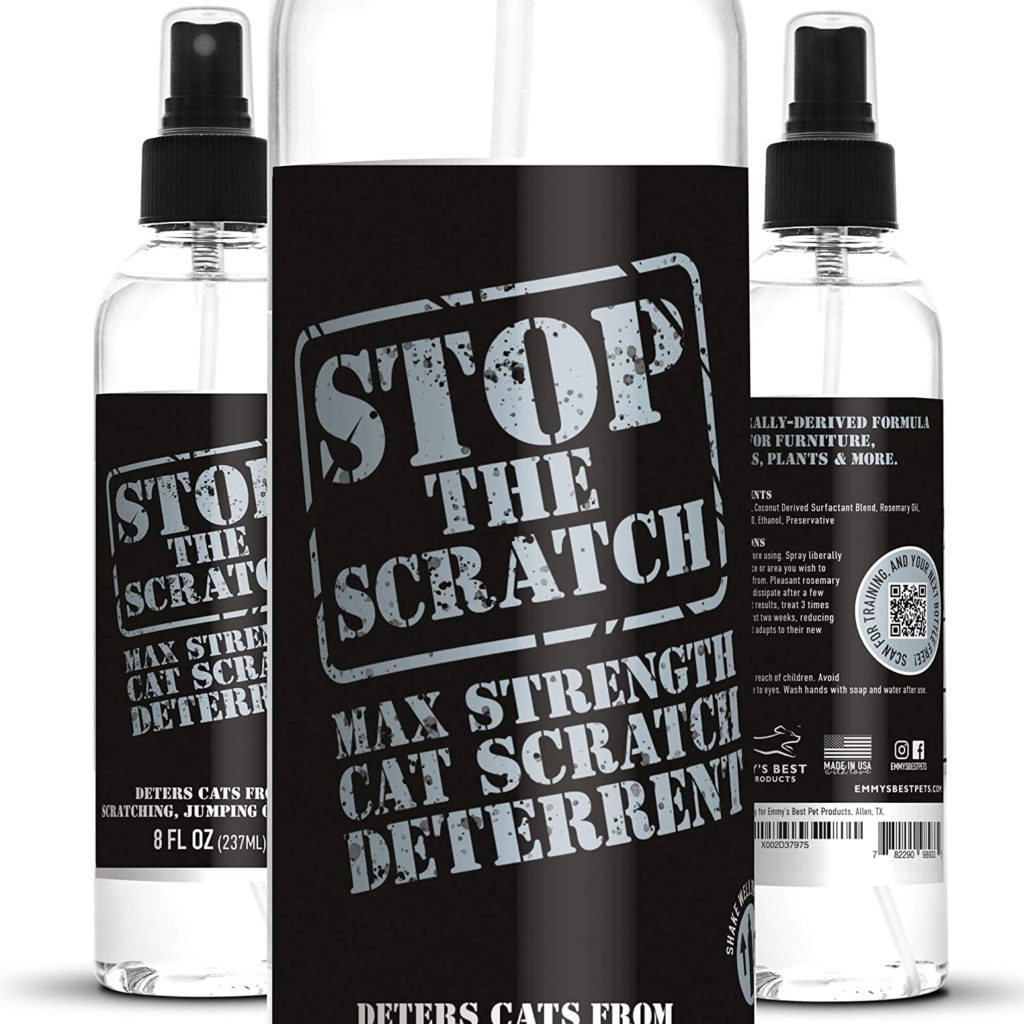
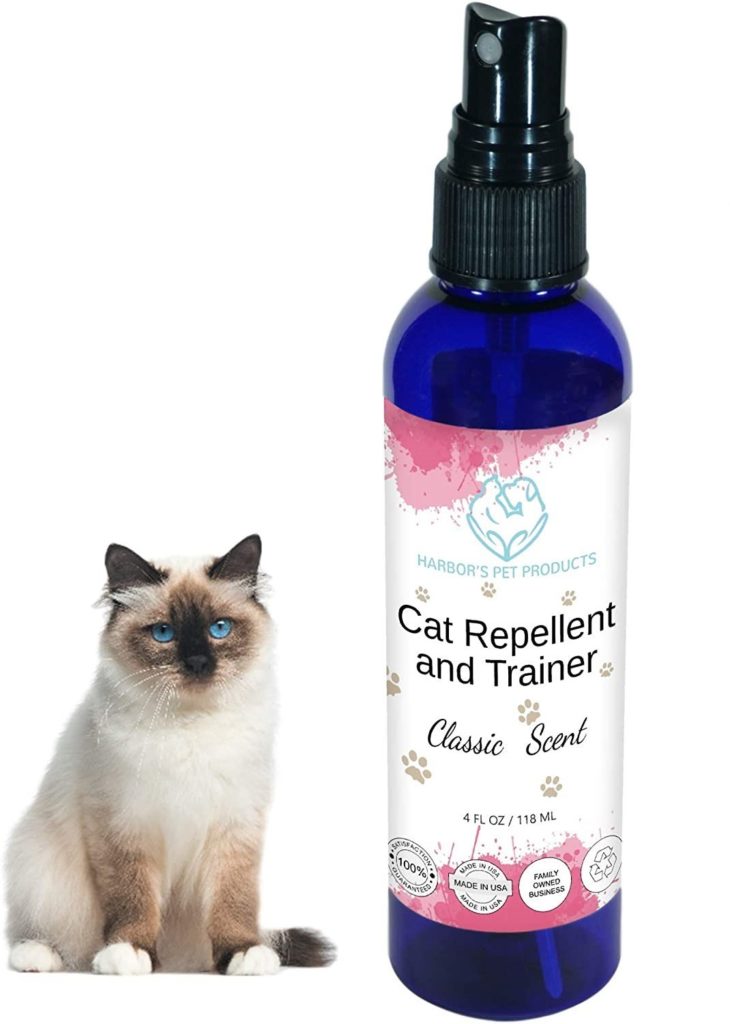



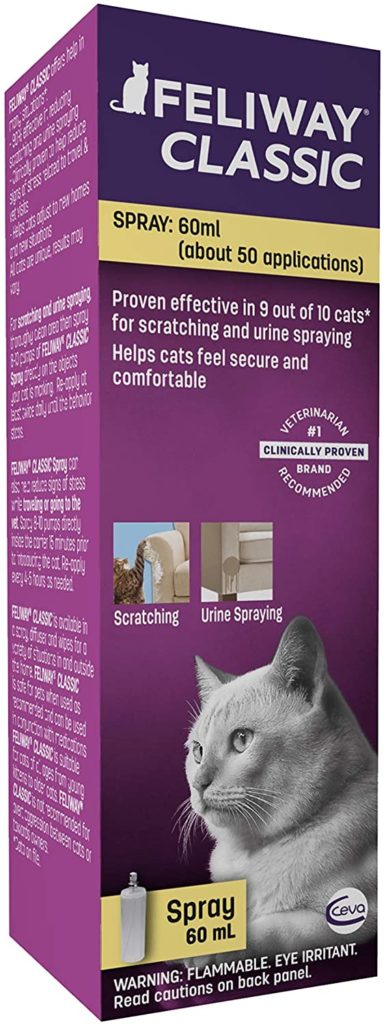
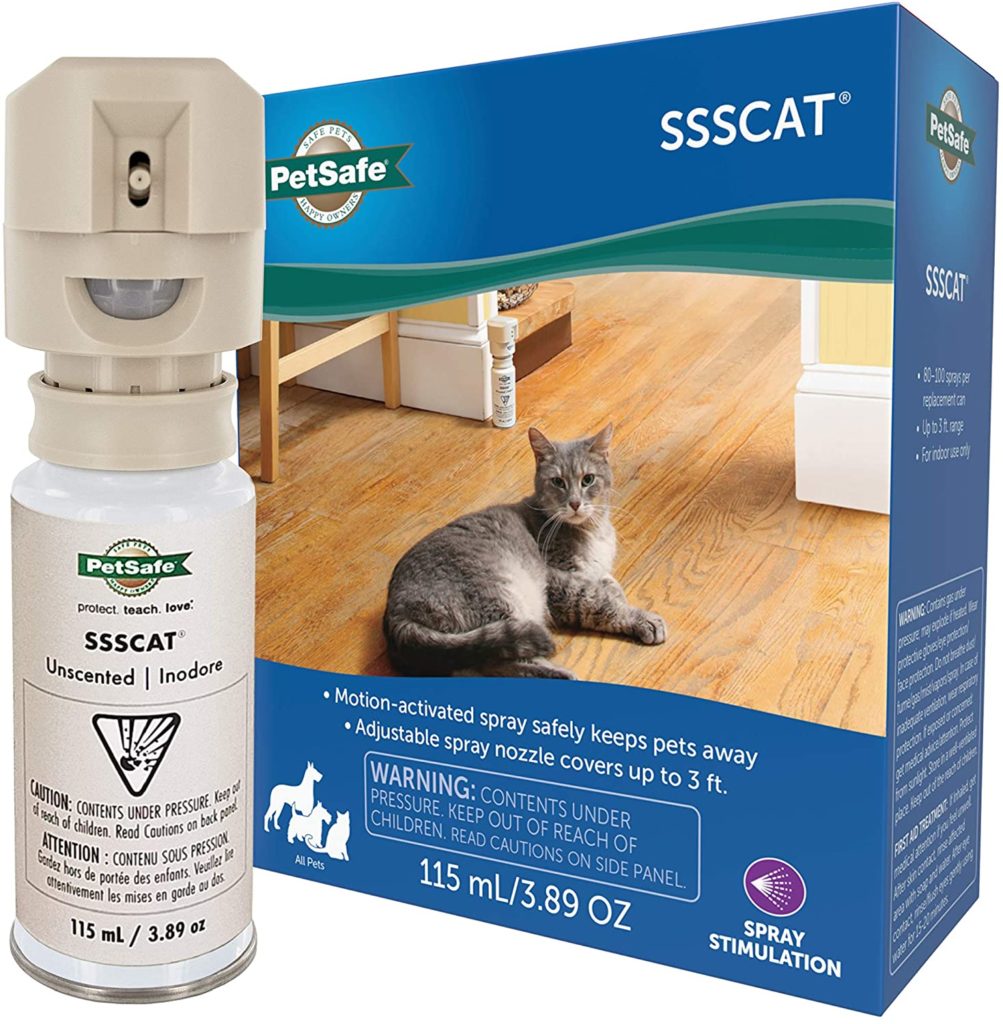
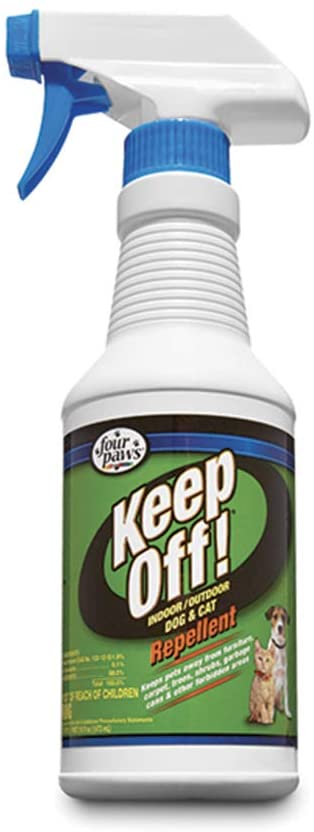
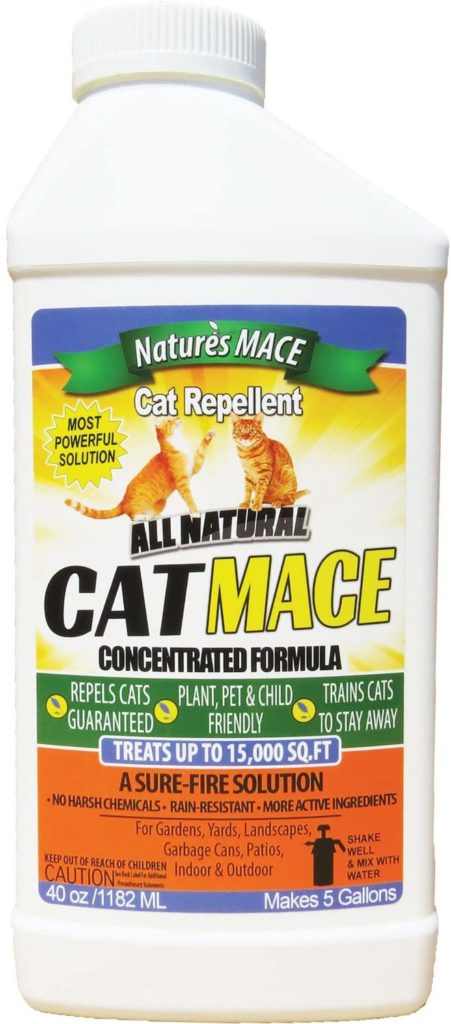




No comment yet, add your voice below!